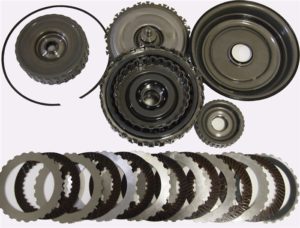Jerky, Sluggish, Juddering, Noise, Under powered, S Mode too extreme, and many more..
These are problem car with DSG gearbox. Several of our customers also said DSG = Dumb Stupid Gearbox.
Mechatronic / Clutch / Flywheel replacement would not solve the problem, due DSG software from factory is made for ECO Driving only and mostly without traffic jam during factory development.
We already tried several famous brand to suit our engine tuning, but none of them satisfied to us.
That’s why UTP Motorsport approached TVS Engineering from Netherlands.
With a stock of 1,000 DSG gearboxes and around 2,000 DSG repairs per year, TVS is only real DSG specialist in the world.
BIG QUESTION: “Is reprogramming of the DSG really needed?”
Lots of tuners still claim that modifying the DSG software is not needed, causing confusion to everyone. The tuning scene suffers from a total lack of DSG knowledge. Even 20+ years of experience in engine tuning, says nothing about someone’s knowledge of DSG.
It is (or was) a trend to overcome DSG-limiting issues by using some ‘tricks’, when modifying the engine software. The tricks cause the engine-ECU to ignore the CAN-BUS commands from the DSG-ECU. An example of such an ignored DSG command is: “lower engine-torque to 100Nm, because of overheating problems”. Ignoring this command will result in damaging the gearbox…
DQ250 is used on engines with maximal torque 350-380Nm. The DSG software has built-in torque limiters. Exceeding 400Nm, DSG will do an engine cut to prevent clutch slippage.
DQ200 is used on engines with maximal torque 260-300Nm. Exceeding that, DSG will do an engine cut to prevent clutch slippage.
Please read carefully:
When the engine and DSG software are not perfectly in harmony, clutch slip and rough up-shifts may occur. And last but not least, the clutch will wear out in say 6-24months. Again: This has nothing to do with the quality and experience of the engine calibrator. To let the DSG function properly, the engine software needs pretty complex modifications, especially when exceeding the 450Nm limit.
What will happen if I do not re-program my DSG?
● Clutch wear
Clutch slip will occur, even though not always clearly noticeable. After roughly 6-24 months the clutch-slip tends to get more and more. The slip is mostly noticeable at +/-3000rpm when the turbo “kicks in”.
● Power loss
Torque is limited to 350-380 Nm on DQ250 and 300Nm on DQ200.
The DSG gearbox has a build-in feature to measure the actual engine torque, if it exceeds specification, then the gearbox will send command to ECU to doing power reduction/engine cut.
Many high-grade tuners deactivate, or better words: ‘try’, to deactivate this function in the engine ECU. In other words: The safety functions are deactivated, so no power reducing when overstressing the gearbox. Result: The gearbox or clutch will break down. Therefore we strongly advice to keep these functions intact to avoid clutch slip&wear. And use our DSG software instead of disabling the safety functions through modifications in the Engine software.
● Shifting problems
Rough incorrect shifting may occur. Mostly at Full Throttle. Launch controls are slower and more symptoms. Simply because the parameters in DSG are set for low torque values only.
Software ‘modification’ or ‘full re-programming’
UTP Motorsport offers a full TVS file solution.
The original software ID and Full Read File will be stored on our database, but the original software itself will not be re-used for our calibration. (what 99% of tuners normally do).
This avoids the common bugs & problems with the numerous factory update’s. TVS-engineering’s workshop encounters these update problems every day. 2000 DSG repairs per year help us learning what files to use, or not to use.
Please click link below for further explanation:
DQ250 (Wet Clutch 6 Speed)
DQ200 (Dry Clutch 7 Speed)
DQ500 (Wet Clutch 7 Speed)
and yes, we can tune DSG DQ380. The 1st in Indonesia!
all explanations above are copyright from TVS Engineering


